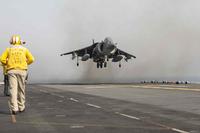Development of the U.S. Navy's first drone refueling tanker -- the MQ-25A -- is progressing but may require some redesign before final bids go out, the head of Lockheed Martin Corp.'s advanced development division said Tuesday.
Rob Weiss, chief of the company's advanced research division known as Skunk Works, said the service wants "the drone to be a refueling tanker intended to deploy rapidly … for a carrier." But service officials are still considering configurations, including strike capability, he said.
The Bethesda, Maryland-based defense giant gave a glimpse into its work, showing a partial image of refueling pod under the aircraft's wing with a hose-and-drogue system during a daylong briefing with reporters at the company's offices in Arlington, Virginia, outside Washington, D.C.
"It's now very tanker focused. We're looking at what those requirements are -- there will probably be a fallout capability, some [intelligence surveillance and reconnaissance] … potentially some strike," Weiss said.
The changed focus will likely require a new design to previous prototypes in the project, he said.
The Navy has awarded four contracts -- to Lockheed, Boeing Co., General Atomics and Northrop Grumman Corp. -- for developmental designs on the MQ-25, known as the Stingray. The service plans to request official proposals from companies this summer. The drone could enter service as early as the mid-2020s.
In October, Northrop became the last competitor to receive a contract for the design effort. The company developed the Navy's X-47B demonstrator carrier-based drone, which is also capable of aerial refueling. In 2015, the X-47B had its first fully autonomous refuel but only as the receiving aircraft of an Omega Air KC-707 tanker.
The Stingray originally was to be part of the Unmanned Carrier-Launched Airborne Surveillance and Strike, known as UCLASS. (The X-47B was part of UCLASS before being re-designated into the Unmanned Combat Air System Demonstration, or UCAS-D program).
In 2016, the Navy converted the project to the Carrier-Based Air Refueling System, or CBARS, and recently renamed the effort again to the Unmanned Carrier Aviation Air System, UCAAS, to reflect the drone's main mission to refuel aircraft in the vicinity of the carrier as opposed to behind enemy lines, Flightglobal reported.
Over the last eight months, Lockheed's Skunk Works has "been working with the Navy, their maritime advanced capability office [and] they're frankly doing all the right things to accelerate this program and get it to the hands of the warfighters," Weiss said.
He added that "solutions" are being worked out to house the MQ-25A properly within the program. Without disclosing details, he said the Navy hasn't finalized its needs and is still sending over new requirements "of what exactly they want this tanker to be."
Weiss said the drone, in enabling carrier operations, would provide "more legs, more reach for both the F/A-18s and the F-35s [at a] more significant range."








